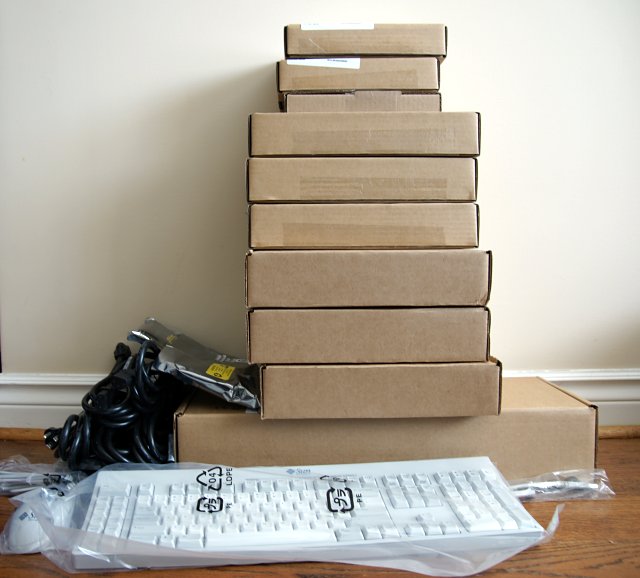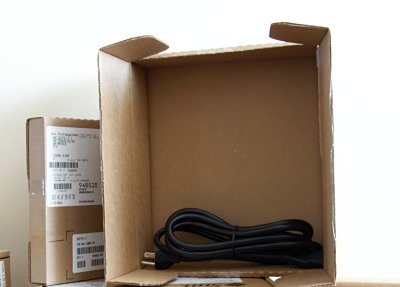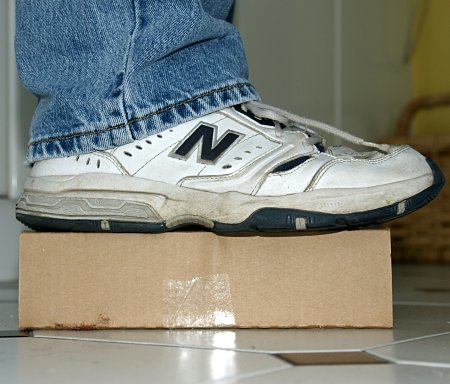
One of the things I love about my day job is getting to play with a lot of technology. One of the things I dislike is that a lot of the technology is packaged very wastefully. The picture above provides a good illustration. Yesterday’s shipment included a very large box that opened to reveal the 10 boxes shown here.
 Each of those boxes then opened to reveal a very loosely packed component: five power cords (three of them individually boxed!), a keyboard & mouse, two sticks of RAM, two small internal expansion cards, and three slimline DVD-ROM drives. Everything removed from these boxes is in the little pile on the left in the top picture.
Each of those boxes then opened to reveal a very loosely packed component: five power cords (three of them individually boxed!), a keyboard & mouse, two sticks of RAM, two small internal expansion cards, and three slimline DVD-ROM drives. Everything removed from these boxes is in the little pile on the left in the top picture.
Now I understand why you’d want to put delicate optical drives in a nice sturdy box with foam padding, and why a company with a lot of inventory would value having a few standard-sized boxes instead of a bunch of loose components. I also understand why a company selling servers would want to ship each server and non-standard component separately and have me assemble them.
 But I’m at a loss to understand why each power cord required its own crush-proof box rated to hold 65 lb and with a burst strength of 200 PSI. When I repacked all this stuff after checking it against the packing slips, it all fit into just one of the pictured boxes with the exception of the keyboard. The rest of the boxes went straight out into the blue bin, having served basically no purpose but to consume space.
But I’m at a loss to understand why each power cord required its own crush-proof box rated to hold 65 lb and with a burst strength of 200 PSI. When I repacked all this stuff after checking it against the packing slips, it all fit into just one of the pictured boxes with the exception of the keyboard. The rest of the boxes went straight out into the blue bin, having served basically no purpose but to consume space.
Why ship in ten sturdy boxes (plus yet another box to hold all of the boxes) when just two will do? Why does each individual power cord need to be shipped in a separate box that a fully-ballasted man can stand on without crushing it? I’m sure the answer is “efficiency,” but I’m not seeing it.
Oh man…..I know how you feel.
Another example was an HP server I received. Among all the other over-packaged stuff inside the box, the one that REALLY caught my attention was a single-page warranty slip. This piece of 8.5×11″ paper was bubblewrapped and placed in its very own box.
Nice. I’ve noticed that server packaging is a little better than it used to be, at least in the sense that the oversized boxes are now filled mostly with air rather than Styrofoam. Packaging of most accessories and add-ons (and, apparently, warranties) still have a way to go. Each of the servers I’m currently working with came with a 2-foot-long box containing just a null modem about the size of a USB thumb drive.
One supposes we could refuse the goods in the first place. Is it really necessary to acquire new equipment? Why not make do with what we have? Is more RAM really necessary? If we did not have a compulsion to get newer ‘stuff’, we could avoid some of the excess packaging.
Alternatively, how about going to a local reseller that assembles components, and picking up your machine already assembled, free of all the boxes? Not sure that the reseller would not receive all the components the same way you did, but at least one less delivery would take place. Being a bike guy, I am sure you could figure out how to transport one box of components without spewing another few pounds of greenhouse gases into the atmosphere.
I agree with everything you said, poika. Indeed, I buy components for my own computers from local dealers and they generally don’t come with all of the retail and shipping fluff. Hard drives, for example, are packaged in nothing more than a static bag, and I carry them home in my backpack or man-purse by bike or TTC.
Unfortunately, these aren’t my systems; they’re servers I’m working with for a customer. This is how they come from the local reseller, and it’s how they receive them from the manufacturer. Even if the reseller assembled everything and all I received was a single box with everything in it, all of the waste would already have been generated; it would just be in someone else’s blue bin.
I’d like to see a law that requires companies (whether retailers or manufacturers) to take back packaging from the end user. After all the bitching and complaining was over, you can bet that a lot of packaging efficiencies would magically emerge.
One of the problems I have with many companies that whine about how expensive it is to be green is that they haven’t yet realized that doing things like cutting out all of this excessive packaging or using less energy will save them money.
Hey Val,
Here’s another great example, courtesy of The Register:
http://www.theregister.co.uk/2008/11/21/more_hp_packaging/
Sheesh. I’ll never understand why companies need to use so much packaging for such a little thing. (In contrast, we received some software at the office this morning: the DVD came in a simple keep case inside a small unpadded FedEx envelope. The licence arrived as a PDF by email. There was no paper documentation. Much better. Electronic delivery for the software would have been better yet, but wasn’t an option in this case.)